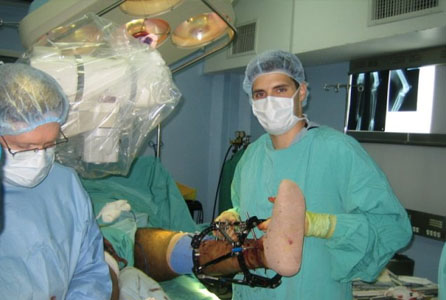
What is Ankle Surgery?
Ankle surgery refers to the removal of the joint’s cartilage portion and the fusion of diseased bones into a single unit through surgery. The joint is usually formed by great cartilage and allows for bone motion that is practically free of pain. Diseased or damaged cartilage allows some motion; however, the motion could be a little bit disabling and painful. Three various bones exist that do not have any cartilage: the talus is dome-shaped on top and gets the cartilage removed from it; the tibia is a long and big leg bone; and the fibula is the long and thin bone on the outer leg. Getting rid of cartilage will expose any underlying bones that fuse and grow onto other bones. The objective of ankle surgery would be to get rid of painful motions of the joint by fusing the talus and tibia bones together, while the fibular bone could also connect to them.
Ankle surgery is done to get rid of pain and improve walking and overall life quality. Usually, people try out conservative options first, which consist of arthritis pain treatment and make use of analgesics and non-steroidal anti-inflammatory medications or even corticosteroid infiltrations. Physical therapy also gets tried out, while ankle braces are put to use to try and make the arthritic joints immobile. Sometimes, this immobilization can also be tried out with cam-walker casts or casts. If the ankle joints have arthrotomy or arthroscopy, procedures are done to try to get rid of or fix arthritic bone or joint cartilage. If such treatments do not succeed, ankle surgery is done.
Trauma, crush injuries and ankle fractures could cause arthritic joints. Chronic arthritis like gouty arthritis, rheumatoid arthritis, traumatic arthritis, extreme osteoarthritis, and various other conditions of arthritis could cause a lot of pain. Ankle joint infections might destroy the cartilages that help with the fusion. Failed ankle surgery like misaligned fractures, failed implants, failed arthrotomy and arthroscopy could all lead to ankle fusion. Several congenital deformities exist that might require ankle surgery and there are also neuromuscular diseases which create painful and unstable ankle joints. Unstable ankle joints after chronic or extreme ligament tears might cause chronic pain. Sometimes, ankle bones could lose their supply of blood and die internally due to a condition called avascular necrosis, which is secondary to trauma. Extreme kinds of arthritic destruction like Charcot arthropathy could also be a cause.
Traditionally, a lot of procedures of ankle surgery existed. Nowadays, most ankle surgeries fall into two basic techniques. Ankle fusion is performed through arthroscopic techniques, which make use of small incisions to get rid of ankle cartilage. Open techniques use bigger incisions in front and outside of the ankle. Inner surgical hardware is put to use to hold bones together and immobilize them, like bone screws, bone plates, bone rods and staples. Outer devices of surgical fixation can also be put to use. Sometimes, bone grafts will be added if significant bone defects or destruction exists.
